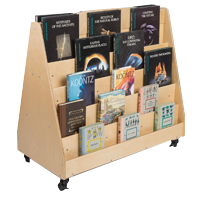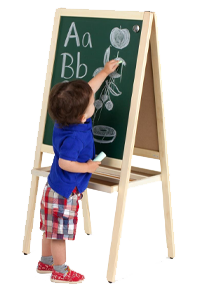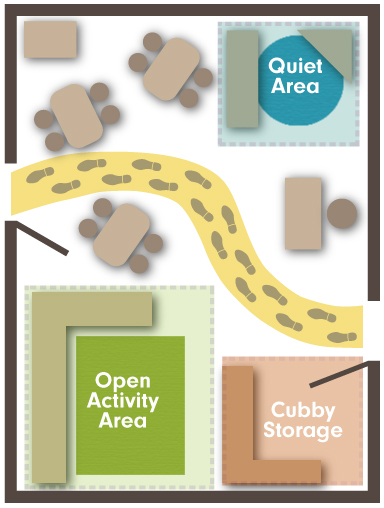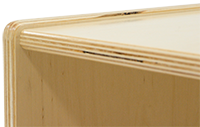Infant Room Daycare Decorating Ideas
Daycare setup is pivotal in the success and effectiveness of any childcare facility, whether it's a non-residential daycare or a home daycare center. Creating your daycare layout is more than playful decorations and lots of toys. A well-designed setup involves strategy and planning to craft the perfect environment for learning and development. From choosing child-safe furniture to daycare decorating ideas to room layout, we've broken down the do's and don'ts of designing your daycare setup.
Core Areas
Daycare classrooms can vary wildly from one to another, though most are made up of the same core areas. All daycare setup ideas should use these "zones" as the foundation for your layout.
Entrance - distinct and welcoming.

Cubby Storage - where children keep their belongings, including backpacks, coats, etc. Situate near the entrance of the room in such a way that it will not be congested during busy pickup and drop-off times. Cubbies should have an open front and size appropriate for its intended users. Other daycare storage ideas, including coat hooks and shelving, can also be part of the cubby storage area.
Classroom & Teacher Storage - for supplies, equipment, toys, materials, books, and other daycare essentials. Keeping your daycare classroom clutter-free is not just for aesthetic purposes: it provides a safer environment for children, helps promote organizational and social skills, and reduces anxiety - for children and teachers. Most storage should be open faced and without doors to avoid finger entrapment and other injuries, except for teacher storage. Store medicines, cleaning supplies, and other unsafe items should be kept in lockable cabinets or storage units.
Quiet Area - low-energy and low-traffic space. Whether it's a nap area for toddlers or a study area for school-aged students, having a quiet area for children to retreat to helps a balanced environment. Provide ample "soft" materials like plushy carpeting, floor mats, pillows, bean bag chairs, etc. for children to recharge or focus on their homework.
 Open Activity Area- the multi-use section of the classroom. Typically the largest area of the classroom, this space needs to be mostly open, free of obstructions, and versatile to suit ever-changing needs and activities. This area is perfect for play activities like block building, reading time, music, sand and water play, arts and crafts, and more. Oftentimes, the eating and meal area is incorporated into this space. The composition and specifics of the open activity are dependent on the intended age group.
Open Activity Area- the multi-use section of the classroom. Typically the largest area of the classroom, this space needs to be mostly open, free of obstructions, and versatile to suit ever-changing needs and activities. This area is perfect for play activities like block building, reading time, music, sand and water play, arts and crafts, and more. Oftentimes, the eating and meal area is incorporated into this space. The composition and specifics of the open activity are dependent on the intended age group.
Age Specific Areas
Daycare facilities care for ages ranging from infants to school-aged children. Though only a few years separate these age groups, the difference in their levels of development can be vast. Therefore, each age group has its own set of unique needs. Here are some daycare setup ideas to accommodate these different groups.
Diapering Area
for infants, toddlers, and preschoolers
Position your diaper changing station to face out into the room so you can still see the room. Place a storage unit nearby for diaper bags, clothing, and other supplies.
Crib Area
for infants
Create a separate room for this when possible to allow for a noise-free environment for babies to rest. Furnish with adult rocking chairs, cribs, and other daycare furniture. Place bottle station nearby.
Nap Area
for toddlers, preschoolers, and kindergarteners
Dedicate a separate room to this area when possible. If not, separate from the busier areas of your room. Furnish with cots, mats, floor pillows, and other daycare furniture.
Personal Storage Area
for kindergarteners
Older children need a separate space for their clothing, books, papers, and other belongings after the school day. If you're looking for daycare storage ideas for these students, open-faced lockers with coat hooks are a great option.

Open Activity Area
The setup of this area is extremely dependent on the age of its users and their current development needs.
- Use carpeting, area rugs, floor mats, etc. in activity areas. Opt for non-slip solutions to prevent injuries and accidents.
- Stock area with blocks, puzzles, and other toys.
- Toddlers: For toddlers, a major goal is promoting large motor skills.
- Design wider pathways to allow for free movement.
- Allow for sand and water play. If possible, position activity area near sink.
- Preschoolers: Encouraging movement and expanding exposure to new interests is greatly emphasized with preschoolers.
- Plan for this area to be larger than activity areas for infants and toddlers as preschool children tend to have more energy and need more space.
- Include a large number of interest areas, configured for small groups of children.
- Kindergarteners & Up: For school-aged children, this area needs to allow for free movement and activities as well as quiet space for homework. Create a configuration that promotes cooperative play and group activities.
- Provide plenty of table space for projects and activities.
- Plan for ample storage areas for a larger inventory of supplies and materials.
- To create a dynamic learning environment, try using multi-functional furnishings like child sized whiteboard tables.
Setting Up Your Daycare Layout
Daycare layout plays a big role in your day to day. If it's well-organized, children can navigate it with ease. But, if it's poorly set up it can make your job infinitely more difficult by promoting bad behavior, not engaging children, causing injuries, etc. To avoid your classroom turning into a hellacious death trap, here are some basic rules of daycare room setup.

Create a Circulation Path - One way to keep your daycare room layout in order is to define a clear path of travel within your room. Creating a shorter, direct path from entrance to exit frees up more space for your activity areas, too.
Place Busier Areas Near Circulation Path - Position tables and other areas prone to more crowded activities next to your path of travel. Corners and floor space dedicated to quiet and development-based activities, like reading time, should be situated away from the path to avoid disruptions.
Design Visual Boundaries - Create definition so children can easily know where learning areas start and stop. Use color, room decorations, rugs, shelving units, and other classroom fixtures to separate your spaces.
Utilize Nooks and Wall Space - Corners and wall space are prime real estate in a daycares and classrooms. Don't waste it on room equipment and furniture. Pull any fixtures away from the wall and use these spaces for quiet reading areas and displays. Opt for products like rolling book cases, double-side storage islands, and other versatile daycare storage ideas that can serve as room dividers and function well in the center of a room.

Use Appropriate Furniture - Select furnishings and fixtures that are size and age appropriate. When possible, buy from a manufacturer that specializes in daycare furniture. Unlike general purpose furniture, daycare furniture is designed specifically for use by children with features like rounded edges, low heights, deep shelving, protective coating, etc.
Decorate Smartly - It's easy to find daycare decorating ideas these days, but be careful to not go overboard. Engaging and stimulating children through texture and color is important, but needs to be done tastefully to avoid sensory overload. Avoid using strong color schemes and large areas of complex patterns, especially on walls and flooring. Use colors to create boundaries between classroom areas.
Finishing Touches
What sets an excellent daycare setup apart from the rest is simple: think like a child. Design your space from the child's perspective. Even if it means getting down on your hands and knees and crawling around, it's important to see the world as they do.
High quality daycares should encourage exploration and learning, provide a sense a security and safety, build social and motor skills, and enrich each and every child's day. It's a tall order, but having a well-designed layout is one of the greatest tools for building a successful daycare program.
Infant Room Daycare Decorating Ideas
Source: https://www.displays2go.com/Article/Designing-Your-Daycare-Setup-77
Posted by: marshallbelank.blogspot.com

0 Response to "Infant Room Daycare Decorating Ideas"
Post a Comment